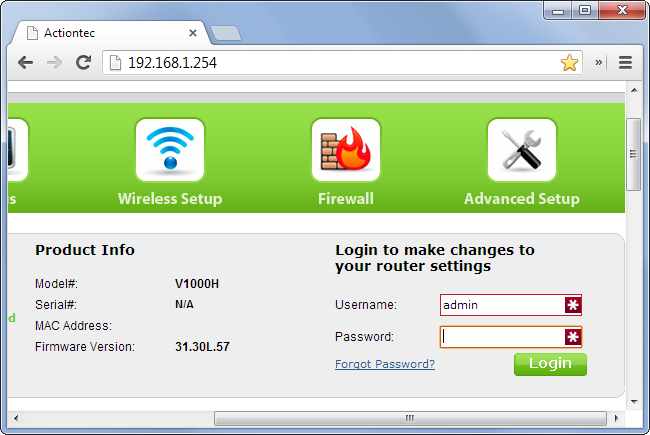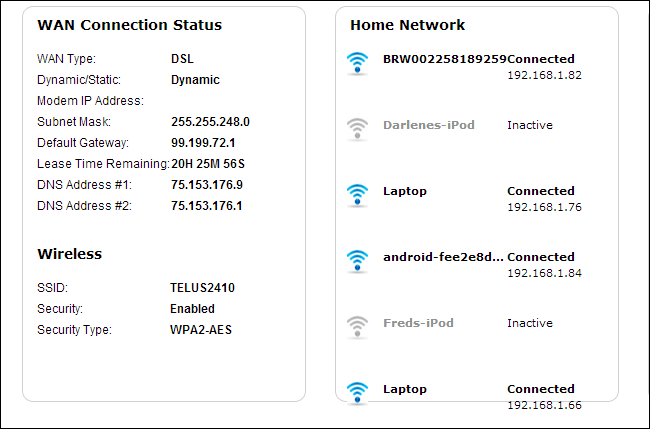10 USEFUL OPTIONS YOU CAN CONFIGURE IN YOUR ROUTER'S INTERFACE
10 USEFUL OPTIONS YOU CAN CONFIGURE IN YOUR ROUTER'S INTERFACE

Your wireless router has a variety of useful options you can configure. These are practically hidden — you wouldn’t know these features exist unless you were digging through your router’s configuration pages.
Bear in mind that different routers have different options. You may not have all the options listed here on your own router. The options will also be in different places with different names.
Accessing Your Router’s Web Interface
The vast majority of routers have web-based configuration pages that you can access in your web browser as long as you’re on the same local network as the router. To access your router’s web interface, you’ll just need to plug your router’s local IP address into your web browser’s address bar.
To find its IP address, open the Network and Sharing Center in the Windows Control Panel. Click the name of your Internet connection.

Click the Details button to view more information about the connection.

Look for the IPv4 Default Gateway IP address in the details window. Plug this IP address into your web browser’s address bar.

RELATED ARTICLE
 How to Access Your Router If You Forget the Password
How to Access Your Router If You Forget the Password
You’ll need to log in with your username and password combination. If you don’t know these, your router is probably using its default combination — check your router’s manual or perform a web search for its model number and “default password.” If you’ve previously changed the password and can’t remember it, you can reset your router’s password to the default.
Once you’ve logged in, you can now browser your router’s configuration pages and configure its settings.

See Who’s Connected
RELATED ARTICLE
 How to Find Your Private and Public IP Addresses
How to Find Your Private and Public IP Addresses
Your router likely provides a way to see who’s connected to your wireless network. This may be on a general status page or in the wireless section behind a button named “clients list” or similar.
If you give your devices and computers meaningful names, this will help you verify that only approved devices are connected.
The router’s administration pages also show other information about the Internet connection, including your external IP address.

Wireless Channel
You can modify a variety of wireless network settings in your router’s web interface, including its wireless channel. Changing your router’s wireless channel can speed up your Wi-Fi. If many other wireless networks in your area are using the same wireless channel, interference will result in a slower connection.
Before changing your wireless channel, use something like Wi-Fi Analyzer for Android or the inSSIDer utility for Windows. They’ll scan the networks in the local area and find the best wireless channel with the least interference.

RELATED ARTICLES
 How To Get a Better Wireless Signal and Reduce Wireless Network Interference
How To Get a Better Wireless Signal and Reduce Wireless Network Interference
 Change Your Wi-Fi Router Channel to Optimize Your Wireless Signal
Change Your Wi-Fi Router Channel to Optimize Your Wireless Signal
Repeating
If you need to create a wireless network covering a large area, one router may not be enough. You’ll have to use multiple routers, but you don’t necessarily want to create separate wireless networks for each individual router. With the repeating feature found on many routers, you can have the router join itself to the main network, functioning as a repeater for that network. This allows you to create one large Wi-Fi network from many different routers.

Quality of Service
Many routers contain quality of service, or QoS, features. QoS prioritizes traffic to give you a better experience. For example, QoS can reduce the network bandwidth available to BitTorrent transfers and prioritize web pages, preventing your BitTorrent transfers from slowing down your web browsing. This is particularly useful if you have a network with multiple people and want to prevent one bad apple from slowing down the entire network. QoS features are often fairly configurable, so you may even be able to prioritize one computer’s network connections over others.

Dynamic DNS
If you’re hosting some sort of server on your computer, you’ll need to be able to connect remotely. However, many ISPs assign dynamic IP addresses that change regularly. Dynamic DNS gets around this by assigning a special address like yourcomputer.service.com to your computer. Whenever your external IP address changes, your router will check in with the dynamic DNS service and update the IP address associated with yourcomputer.service.com, so you’ll always be able to connect to your computer there.
Routers generally have Dynamic DNS or DDNS pages where this feature can be configured. You’ll need to create an account with a supported service and choose a hostname first — check your router’s DDNS page for a list of supported services.

Port Forwarding, Port Triggering, DMZ & UPnP
Because of the way network address translation (NAT) works, routers block incoming traffic by default. If you want to set up a computer as a server or use other services that require incoming connections — such as peer-to-peer file transfers or some forms of VoIP — you may need these incoming connections.
Routers provide a variety of ways to enable this. You can forward ports so incoming connections on these ports will always be sent to a certain computer. You can set up port triggering, so port forwarding will automatically be enabled whenever a program opens a connection on a certain port. You can use a demilitarized zone (DMZ) to automatically send all incoming connections on your network to a single computer. UPnP is also generally enabled by default. UPnP allows programs to forward their own ports on demand, although it isn’t very secure.

RELATED ARTICLES
 How to Forward Ports on Your Router
How to Forward Ports on Your Router
 Do I Need a Firewall if I Have a Router?
Do I Need a Firewall if I Have a Router?
If you’re setting up port forwarding or a DMZ, you’ll probably also want to assign a static IP address so the internal computer’s IP address won’t change and break your port forwarding rules. All of these options — and more — are available in your router’s web interface
Network-Wide DNS Server
You can change the DNS server for your entire network on your router. This allows you to enable parental controls for every device on your network or just make them use a faster DNS server. There are many reasons why you might want to use a third-party DNS server.

RELATED ARTICLES
 The Ultimate Guide to Changing Your DNS Server
The Ultimate Guide to Changing Your DNS Server
 4 Ways to Set Up Parental Controls On Your Home Network
4 Ways to Set Up Parental Controls On Your Home Network
Parental Controls, Website Blocking, and Access Scheduling
Routers often contain parental control features, allowing you to block certain types of traffic or specific websites. You may also be able to control times when Internet access is disabled, preventing your children from using the Internet at 3 a.m.. On some routers, you may even be able to configure this on a per-computer basis, limiting only specific computers.
Even if your router doesn’t contain parental controls, you can still set up parental controls by changing your DNS server to OpenDNS.

Reboot
You may want to reboot your router if you’re experiencing network issues. You can do this by unplugging the router or pressing a button on it, but the router may be in a hard-to-get-to location.
You’ll usually find a convenient button to reboot your router somewhere on its configuration pages, so you can reset your router without even getting up.

For Advanced Users: Third-Party Router Firmwares
If you want more out of your router, you can install a variety of third-party router firmwares. You’ll need to have a router that’s supported by these firmwares, so this isn’t for everyone. In fact, if you really want to use these router firmwares, you should take this into account when you buy a router and ensure it’s compatible.
Popular router firmwares include DD-WRT, Tomato, and OpenWRT. These firmwares all provide additional options that you wouldn’t normally get on your router. OpenWRT in particular is a full embedded Linux distribution with a package manager, allowing you to access a Linux shell and install software on your router, effectively allowing you to use it as an always-running, low-power server.

We haven’t covered everything you can do with your router’s web-based administration pages. Feel free to take a look around your router’s web interface and see all the options you can configure. You can also consult your router’s manual for information specific to your router model.

Your wireless router has a variety of useful options you can configure. These are practically hidden — you wouldn’t know these features exist unless you were digging through your router’s configuration pages.
Bear in mind that different routers have different options. You may not have all the options listed here on your own router. The options will also be in different places with different names.
Accessing Your Router’s Web Interface
The vast majority of routers have web-based configuration pages that you can access in your web browser as long as you’re on the same local network as the router. To access your router’s web interface, you’ll just need to plug your router’s local IP address into your web browser’s address bar.
To find its IP address, open the Network and Sharing Center in the Windows Control Panel. Click the name of your Internet connection.

Click the Details button to view more information about the connection.

Look for the IPv4 Default Gateway IP address in the details window. Plug this IP address into your web browser’s address bar.

RELATED ARTICLE
You’ll need to log in with your username and password combination. If you don’t know these, your router is probably using its default combination — check your router’s manual or perform a web search for its model number and “default password.” If you’ve previously changed the password and can’t remember it, you can reset your router’s password to the default.
Once you’ve logged in, you can now browser your router’s configuration pages and configure its settings.

See Who’s Connected
RELATED ARTICLE
 How to Find Your Private and Public IP Addresses
How to Find Your Private and Public IP AddressesYour router likely provides a way to see who’s connected to your wireless network. This may be on a general status page or in the wireless section behind a button named “clients list” or similar.
If you give your devices and computers meaningful names, this will help you verify that only approved devices are connected.
The router’s administration pages also show other information about the Internet connection, including your external IP address.

Wireless Channel
You can modify a variety of wireless network settings in your router’s web interface, including its wireless channel. Changing your router’s wireless channel can speed up your Wi-Fi. If many other wireless networks in your area are using the same wireless channel, interference will result in a slower connection.
Before changing your wireless channel, use something like Wi-Fi Analyzer for Android or the inSSIDer utility for Windows. They’ll scan the networks in the local area and find the best wireless channel with the least interference.

RELATED ARTICLES
 Change Your Wi-Fi Router Channel to Optimize Your Wireless Signal
Change Your Wi-Fi Router Channel to Optimize Your Wireless SignalRepeating
If you need to create a wireless network covering a large area, one router may not be enough. You’ll have to use multiple routers, but you don’t necessarily want to create separate wireless networks for each individual router. With the repeating feature found on many routers, you can have the router join itself to the main network, functioning as a repeater for that network. This allows you to create one large Wi-Fi network from many different routers.

Quality of Service
Many routers contain quality of service, or QoS, features. QoS prioritizes traffic to give you a better experience. For example, QoS can reduce the network bandwidth available to BitTorrent transfers and prioritize web pages, preventing your BitTorrent transfers from slowing down your web browsing. This is particularly useful if you have a network with multiple people and want to prevent one bad apple from slowing down the entire network. QoS features are often fairly configurable, so you may even be able to prioritize one computer’s network connections over others.

Dynamic DNS
If you’re hosting some sort of server on your computer, you’ll need to be able to connect remotely. However, many ISPs assign dynamic IP addresses that change regularly. Dynamic DNS gets around this by assigning a special address like yourcomputer.service.com to your computer. Whenever your external IP address changes, your router will check in with the dynamic DNS service and update the IP address associated with yourcomputer.service.com, so you’ll always be able to connect to your computer there.
Routers generally have Dynamic DNS or DDNS pages where this feature can be configured. You’ll need to create an account with a supported service and choose a hostname first — check your router’s DDNS page for a list of supported services.

Port Forwarding, Port Triggering, DMZ & UPnP
Because of the way network address translation (NAT) works, routers block incoming traffic by default. If you want to set up a computer as a server or use other services that require incoming connections — such as peer-to-peer file transfers or some forms of VoIP — you may need these incoming connections.
Routers provide a variety of ways to enable this. You can forward ports so incoming connections on these ports will always be sent to a certain computer. You can set up port triggering, so port forwarding will automatically be enabled whenever a program opens a connection on a certain port. You can use a demilitarized zone (DMZ) to automatically send all incoming connections on your network to a single computer. UPnP is also generally enabled by default. UPnP allows programs to forward their own ports on demand, although it isn’t very secure.

RELATED ARTICLES
 How to Forward Ports on Your Router
How to Forward Ports on Your Router Do I Need a Firewall if I Have a Router?
Do I Need a Firewall if I Have a Router?If you’re setting up port forwarding or a DMZ, you’ll probably also want to assign a static IP address so the internal computer’s IP address won’t change and break your port forwarding rules. All of these options — and more — are available in your router’s web interface
Network-Wide DNS Server
You can change the DNS server for your entire network on your router. This allows you to enable parental controls for every device on your network or just make them use a faster DNS server. There are many reasons why you might want to use a third-party DNS server.

RELATED ARTICLES
 The Ultimate Guide to Changing Your DNS Server
The Ultimate Guide to Changing Your DNS Server 4 Ways to Set Up Parental Controls On Your Home Network
4 Ways to Set Up Parental Controls On Your Home NetworkParental Controls, Website Blocking, and Access Scheduling
Routers often contain parental control features, allowing you to block certain types of traffic or specific websites. You may also be able to control times when Internet access is disabled, preventing your children from using the Internet at 3 a.m.. On some routers, you may even be able to configure this on a per-computer basis, limiting only specific computers.
Even if your router doesn’t contain parental controls, you can still set up parental controls by changing your DNS server to OpenDNS.

Reboot
You may want to reboot your router if you’re experiencing network issues. You can do this by unplugging the router or pressing a button on it, but the router may be in a hard-to-get-to location.
You’ll usually find a convenient button to reboot your router somewhere on its configuration pages, so you can reset your router without even getting up.

For Advanced Users: Third-Party Router Firmwares
If you want more out of your router, you can install a variety of third-party router firmwares. You’ll need to have a router that’s supported by these firmwares, so this isn’t for everyone. In fact, if you really want to use these router firmwares, you should take this into account when you buy a router and ensure it’s compatible.
Popular router firmwares include DD-WRT, Tomato, and OpenWRT. These firmwares all provide additional options that you wouldn’t normally get on your router. OpenWRT in particular is a full embedded Linux distribution with a package manager, allowing you to access a Linux shell and install software on your router, effectively allowing you to use it as an always-running, low-power server.

We haven’t covered everything you can do with your router’s web-based administration pages. Feel free to take a look around your router’s web interface and see all the options you can configure. You can also consult your router’s manual for information specific to your router model.



Comments
Post a Comment
Awesome!🤩 Thanks for your comment! TIQS❤️